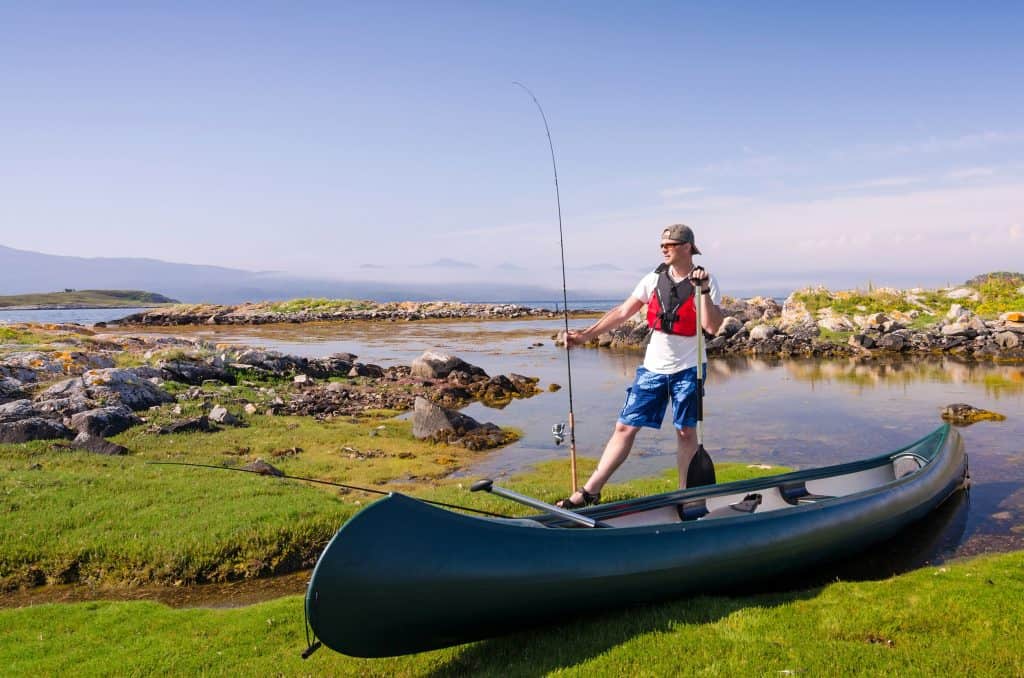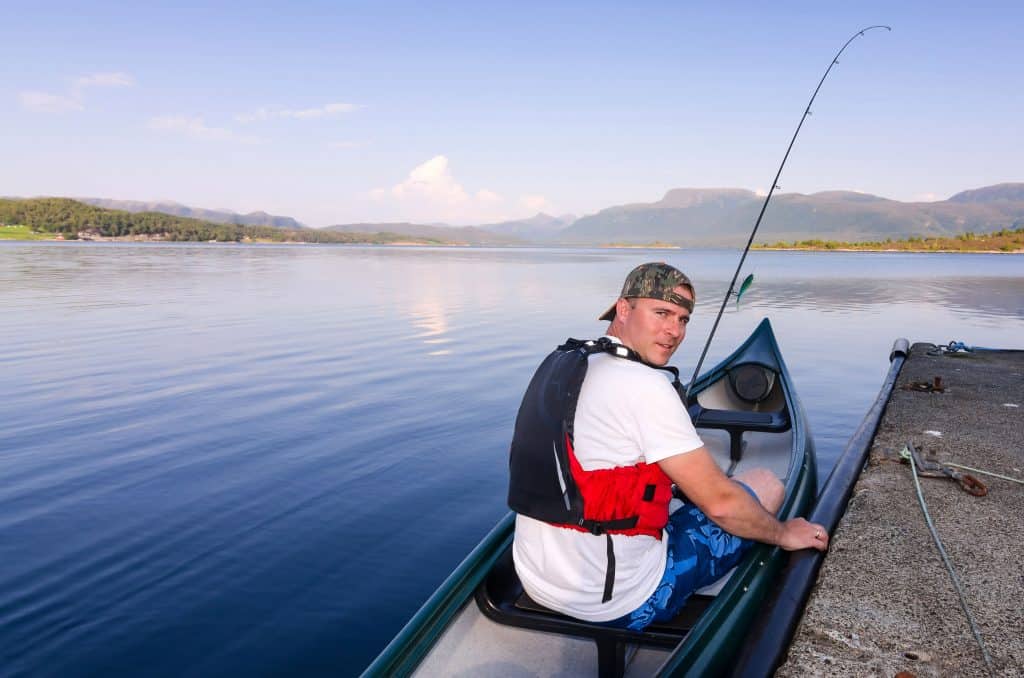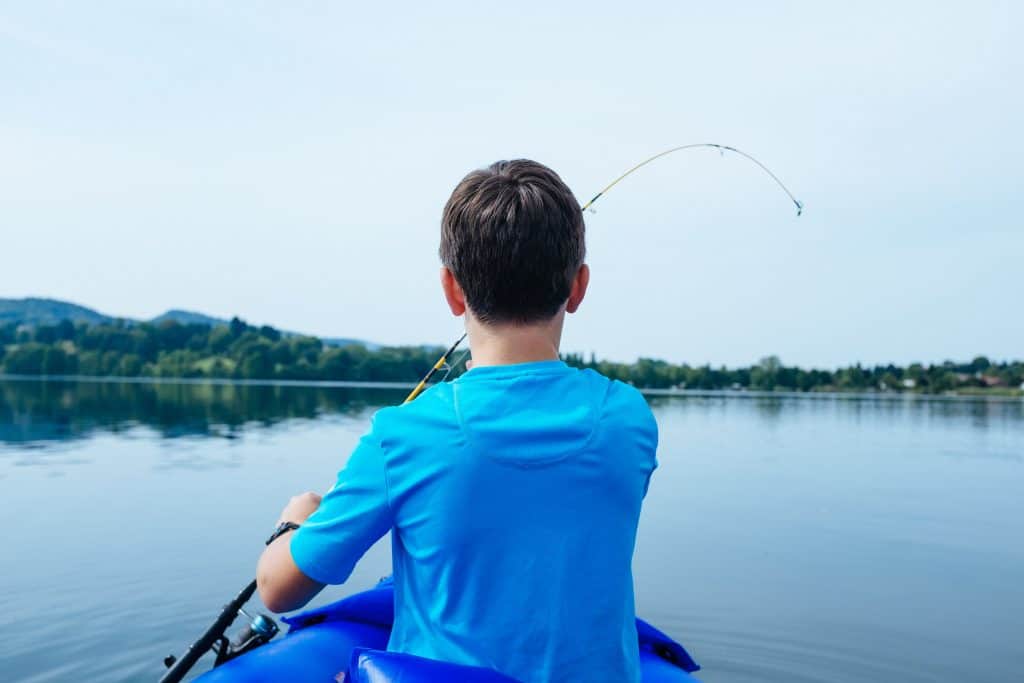
Some people have a knack for making fishing look like a breeze when in all reality fishing takes a lot of hard work, time, and consistency. When fishing from a canoe it’s best to not only know the basics of fishing but to find some other tips that will help make your fishing experience relaxing and fun.
So, let’s talk about some specific tips you can use to prepare yourself and your canoe for a great fishing trip.
1. Get Permission to Fish
Most people think that the hardest part about fishing is trying to get a license. Most states allow residents to get fishing licenses online, over the phone, or at some retail establishments. However, when thinking about purchasing a license online, be careful! There are many websites that are not authentic and will take your money without actually sending you a license.
To be safe, if buying a license online, it’s best for you to look up your state’s department of fish and game website. It is the safest way to get a license online. You can also find a phone number to call and purchase a fishing license on the same website.
You can usually go to any fishing or hunting store and be able to purchase a license, in some states you can even purchase a fishing license from Wal-Mart or a grocery store.
2. Get More Information About the Water Your Fishing in and the Weather
Knowing the water you’ll be fishing in can help a great deal for having a successful fishing trip. A great way to find out information about the lake you will be fishing in is to search it on the internet.
More than likely, the lake will have its own website. You will be able to find and discover what kind of fish are available at that lake, the rules for fishing on that lake, the limit of the amount of fish you can catch on that lake, stocking records and schedules, the best season for fishing, and many other bits of information that will help you have the best experience.
It is also incredibly important to know what weather you will be facing when you go fishing. We all know that just because we wake up to a sunny day, doesn’t mean it will stay that way. Even if the weather isn’t ideal as long as you are aware of the conditions that are presented, you should be okay.
Fog – Although fog is not super dangerous, it can be easy to lose track of where you are in the water when fog arises. You could easily get lost and unfortunately, keep you out in the weather and the water longer than you are prepared for.
Wind – Wind happens all the time, every day. Most of the time it won’t affect you too badly, but if the wind is heavy it can create choppy waves, which can make your canoe less stable, and make it easier to overturn.
Rain – Fishing while it’s raining is normally not a bad thing. Rain can easily be prepared for, and it doesn’t have to cancel your fishing plans. Make sure that you are prepared to stay dry and comfortable. Bring something in your canoe: like an umbrella or a rain jacket, and perhaps a change of clothes. to ensure you keep dry. While rain can usually be fine when fishing if mixed with cold weather can present problems.
Lightning – If you see lightning or hear thunder you should immediately head back to shore, and either wait for the storm to pass or try another day. It can be incredibly dangerous to be out on the water during a storm, especially when fishing. You should immediately lay your fishing rod down flat in your canoe to keep it from acting as a lightning wand.
3. Be Prepared but Don’t Overpack
The key to making sure your canoe is ready to head out onto the lake to fish is packing your fishing gear lightly! If you decide to bring every piece of fishing gear you can think of that can ultimately make you lose focus on the very thing you over packed for. Bring only what you need and stick to a few lures and you should be fine.
Bring safety equipment as well. Even if you’re sure that your water will be calm and still, always wear a life jacket. You never know what could happen that you would need to be wearing one. Make sure your canoe is equipped with flares, gloves, a flashlight (even if you think you won’t be out in the dark), and a first aid kit. Pack bug spray and sunscreen as extra precautions.
Bringing food and water is essential. Staying hydrated while fishing is important, so make sure to bring enough drinking water with you. Pack foods that are water-rich, like fruit, and lean protein snacks that will keep your energy up.
4. Talk to the Employees at Fishing Stores to Get the Best Equipment
You can easily look up online the best fishing equipment for the fish you’re trying to catch and the water you plan to fish in.
You can also go to any fishing store and find the best of the best equipment from talking to the people that work there. Employees are trained to know what works best for what conditions, so don’t be shy about checking in to make sure you have what you need.
The more information you have the more likely you are to find the best equipment. Learn what bait works for the fish you want and what rod is best for you.
Also, make sure to bring fish handling gear as well. Make sure to have gloves, pliers, nets, line cutters, fish grips, and stringer. Also, make sure to have back up lures and hooks just in case.

5. Organize and Plan to Catch Multiple Fish
Organization while fishing is extremely important if you plan on catching more than one fish. Make sure to have three or four to go combos of bait at the ready. Have not only moving bait at the ready but deep baits as well.
Keep your frequently used items close to you and easily accessible. It’s easier to keep what you need out in an organized manner than have to go back and dig through your tackle box over and over again trying to find something.
It’s good to know what works in a certain area and what doesn’t so that you don’t have to waste time changing things up when you can’t catch any fish. Staying organized is the key to have the most efficient fishing experience.
6. Kneel on the Seat for Stability
Staying centered while fishing in a canoe is common sense, but can be tricky to ensure at times. Most likely you will find it easier to sit or kneel in your canoe while fishing.
Kneeling off the seat gives you more stability because it not only lowers your center of gravity but it gives you closer contact and control with the canoe than usual. More than half of your body weight should still be on the seat of the canoe which helps relieve pressure from your legs. You can also easily install knee pads in your canoe for extra comfort.
Standing in a canoe is best done when the canoe is still and anchored in the water. You should start by having your gear at the ready, and rise to a crouching position. Then, slowly raise yourself up by your arms placed on both sides of the canoe and planting your feet firmly on the floor of the canoe.
When standing you want to make sure you are centered with the center of the canoe to keep the canoe from tipping too much to one side.
7. Move Quitely By Adding a Trolling Motor to Your Canoe
Being quiet while fishing is a no brainer but can sometimes be hard to accomplish. One great way to stay as quiet while moving through the water is to attach a trolling motor to your canoe. Trolling motors are great for fishers and are incredibly quiet in the water and rarely disturb the fish.
For more information about trolling motors, you can check out my article about them right here on Outdoortroop.
Paddle noise is usually a big problem when fishing but is easily fixed. All you have to do is pay attention to the paddle. If you are slow and purposeful with your paddle you can keep it quiet. Take your time and go slow. Fishing is not about racing, so as long as you’re slow and careful with your paddle you can minimize noise.
However, fishing is made much easier by adding a trolling motor, so it’s worth the investment.
8. Attach Imitation Bait to the Canoe
Trolling in a canoe is simply moving through the water. However, you can move from one place to another and still be sure you will find fish wherever you move.
One great way to keep fish with you as you troll is to attach something shiny to the back of the canoe. This can be a shiny imitation bait or even something as simply as a metal spoon or fork that will catch the sun as you move through the water. Fish will flock to anything they find shiny in the water.
Another great trolling technique is to troll crankbaits. This allows you to find where the fish are hiding as you travel. A great crankbait that I find most efficient are chartreuse Berkley Flicker Minnow, which you can buy for as low as 3 dollars and 50 cents. As you are moving this particular bait has a way of getting down deep in the water.
As you’re trolling, your crankbait look for the ticking of your rod tip and the bait bounces off the bottom and make sure to real up a couple of turns to keep it in a good position. One thing you will need when doing this particular technique is a rod holder, to make sure your rod stays in place and has no way of falling out into the water.

9. Drift in Your Canoe
Drifting in a canoe is a great way to catch fish, especially the walleye species. Simply drift a combo of a pink 3/8 ounce jig and a white twister as you keep your canoe sideways in a current. Make sure to drop the jig upstream first and let it sink. The key to drifting is to keep a tight vertical line, which means you will have to use a heavier jig in faster water.
Make sure to keep your rod tip high and feel for the bottom as you drift. if you drift faster and don’t feel the bottom for a while don’t let out more line. Simply reel back in and start again.
You can control your drift direction with minimum paddling. Make sure to change orientation from left to right by a backward thrust of the paddle on either side of your canoe for maximum efficiency.
10. Rig Your Own Canoe
You can easily rig a canoe for fishing on your own, which is a cheaper and more fun option. Although it can be time-consuming to rig your canoe on your own and it can be frustrating if it doesn’t work.
If you want to pay someone to rig your canoe, it can come with more benefits like warranties and the best results however it can get expensive depending on what products you want used.
However, before rigging your canoe make sure to think about the conditions of the water. Here’s a great DIY video about rigging a canoe for fishing.
11. Adjust Your Position According to the Fish You are Looking For
Depending on the fish you want to catch you’ll have to know the best position for your canoe to be in. However, there are universal positions that can help make your fishing successful.
It is just as important to keep yourself centered in your canoe as it is to keep your canoe centered on the water. Be careful to keep your canoe level with the water and not prop up one side on any shore line or ridge.
You always want your bait to be drifting from left to right and right to left in front of you in a current so make sure you are able to keep that position.
The best position to keep your boat in away from the shoreline and parallel to the current. This helps a create the maximum amount of fishing positions in the canoe and helps the lure to move parallel to the boat for the best presentation. And it is important to remember not to fight the wind!
12. Use a Foldable Anchor
Often, anchors while fishing is overlooked. Anchors can offer better stability while fishing and keep you in the best position. The most popular anchor is a folding anchor which can weigh anywhere from 1.5 pounds to 4 pounds. Folding anchors work best for storage. If fishing in flat positions, sometimes a stakeout pole can be used.
However, sometimes using an anchor can get tricky, and most people find they can have the same features an anchor offers by using a nylon rope and tying one end to the canoe and making the other end a loop and flipping it over a rock or wrapping it around a tree stump.

13. Use a 90-Degree Angle When Casting
When casting your rod tip make sure you cast so the angle of the rod is in a 90-degree position. This gives you the best curve for fighting and reeling in fish.
Here’s a video that helps you set the right rod angles.
14. Bring a Cooler and Ice
Many fishers remember to bring all the right equipment but forget to bring anything to store their catches.
You can bring something as simple as a hanging net, but you need to take into considerations the dangers of this for the water you’re in. Where you are keeping a bleeding fish in the water next to your canoe can draw unwanted predators in. If you are fishing in the ocean, or down south I wouldn’t recommend a hanging net as it will draw sharks or alligators to your canoe.
Most fishers however usually just buy a small cooler and pack it with ice before they head out on the water. This minimizes risk and helps keep your catches from spoiling as you fish for the day.
15. Try it Out More than Once
There are two key characteristics to have when you are fishing that will help you put in the best effort you can to get the most results.
Take your time and be patient.
Going slowly in the water increases your chance of a catch, minimizes your noise level, and gives you the best results. Before heading out on the water make sure you plan for a lot of time so that you’re not in a rush to finish.
Being patient is the only way you’re going to relax, have fun, and catch fish when you’re out on the lake. Remember that some days are better than others and don’t get discouraged easily. Don’t give up! Be willing to move around and switch things up. Because you won’t catch anything if you stop trying.
Fishing really can be a fun and relaxing experience, not just for you, but for the whole family. It’s important to remember that although some people make it look like a breeze it takes time and effort and you have to be willing to put in the work.
Also, remember practice makes perfect, and the more you find yourself out on the water the easier things will become for you. Always remember to put your safety first and you will always have the best time! Good luck!
